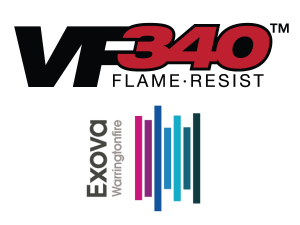VF 340™: Class I Flame Resistant Certification
 ACCREDITATION: To ISO/IEC 17025 for a defined Scope of Testing by the International Accreditation Service
ACCREDITATION: To ISO/IEC 17025 for a defined Scope of Testing by the International Accreditation Service
SPECIFICATIONS OF ORDER: Determine the Flame Spread and Smoke Developed Indices based upon a single test conducted in accordance with ASTM E 84-12c, as per VersaFlex Inc. Purchase Order No. L062813-JW1 and Exova Warringtonfire North America Quotation No. 13-002-197,367 RV1 dated June 20, 2013.
SAMPLE IDENTIFICATION: (Exova sample identification number 13-002-S0420-2) Blue coating material applied to a cement board substrate, identified as: “VF 340” Coating System
TEST PROCEDURE: The method, designated as ASTM E 84-12c “Standard Method of Test for Surface Burning Characteristics of Building Materials”, is designed to determine the relative surface burning characteristics of materials under specific test conditions. Results are expressed in terms of Flame Spread Index (FSI) and Smoke Developed (SD). Although the procedure is applicable to materials, products and assemblies used in building construction for development of comparative surface spread of flame data, the test results may not reflect the relative surface burning characteristics of tested materials under all building fire conditions.
SAMPLE PREPARATION: The coating material was applied to a 0.25 inch (6 mm) cement board substrate (by client). The test sample consisted of 6 sections of material, each approximately 21 inches (533 mm) in width by 48 inches (1219 mm) in length. The sections were butted together to form the requisite specimen length. Prior to testing, the sample was conditioned to constant weight at a temperature of 73 ± 5°F (23 ± 3°C) and a relative humidity of 50 ± 5%. During testing the sample was self-supporting and the coated surface was exposed to the test flame.
The testing was performed on: 2013-07-08
SUMMARY OF TEST PROCEDURE: The tunnel is preheated to 150 ± 5°F (66 ± 2.8°C), as measured by the floor-embedded thermocouple located 23.25 feet (7087 mm) downstream of the burner ports, and allowed to cool to 105 ± 5°F (40.5 ± 2.8°C), as measured by the floor-embedded thermocouple located 13 feet (3962 mm) from the burners. At this time the tunnel lid is raised and the test sample is placed along the ledges of the tunnel so as to form a continuous ceiling 24 feet (7315 mm) long, 12 inches (305 mm) above the floor. Three 8 foot (2438 mm) sections of 0.25 inch (6 mm) cement board are then placed on the back side of the sample end-to-end, to protect the tunnel lid, and the lid is then lowered into place.
Upon ignition of the gas burners, the flame spread distance is observed and recorded every second. Flame spread distance versus time is plotted. Calculations ignore all flame front recessions and Flame Spread Index (FSI) is determined by calculating the total area under the curve for the test sample. If the area under the curve (A) is less than or equal to 97.5 min·ft, then FSI = 0.515·A; if greater, FSI = 4900/(195-A). FSI is then rounded to the nearest multiple of 5.
Smoke Developed (SD) is determined by dividing the total area under the obscuration curve by that of red oak, and multiplying by 100. SD is then rounded to the nearest multiple of 5 if less than 200. SD values over 200 are rounded to the nearest multiple of 50. Section 5.1.9.1 of ASTM E 84-12c could be interpreted to specify a single combination of lamp and photocell to create the requisite optical system. It is anticipated that the section will be clarified to permit alternative, equivalent systems in future revisions of the test standard. In May 2012, the Exova tunnel was modified to include a specially-designed optical measurement system that is utilized by many other tunnel systems worldwide. Although an improvement to performance and reliability is realized, as of this date the new system may not be specifically recognized by ASTM E 84 so this may represent a deviation to the test protocol.
TEST RESULTS:
SAMPLE: “VF 340” Coating System
Flame Spread Index (FSI): 15
Smoke Developed (SD): 150
Observations of Burning Characteristics:
- The sample ignited approximately 36 seconds after exposure to the test flame.
- The flame front propagated to a maximum distance of 4.6 feet (1.4 metres) at approximately 423 seconds.







